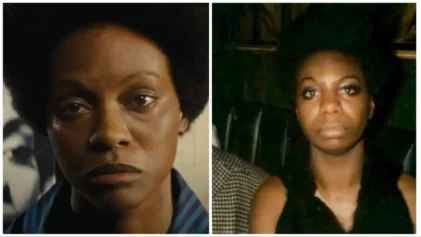
David Redfern / Redferns / Getty Images/RLJ Entertainment
Robert L. Johnson, distributor for the upcoming Nina Simone biopic, believes the controversy surrounding actress Zoe Saldana reflects an interracial “pathology” established by slave owners in the 18th and 19th centuries.
Last month, the trailer and poster for Nina was released, to the dismay of fans who do not want Saldana to portray the “High Priestess of Soul.”
The controversy stems over the issue of skin tone and colorism. Saldana allegedly had to darken her skin with makeup to look similar to Simone. And the actress reportedly used a prosthetic nose to capture Simone’s profound features.
Johnson, founder of BET and head of RLJ Entertainment, said:
“That’s almost saying that dark-skinned Black people have a special cross to bear than light-skinned,” he said. “That is exactly what was put on us, that’s the burden that was put on us by slave owners who separated us by color. I had it when I was running BET. I’d get letters from people saying, ‘Why are all the women in the videos light-skinned women? Can’t there be any dark-skinned women?’ So it’s always been in Black life undercover. This issue about Zoe Saldana and Nina Simone just brought it out to the surface.”
Johnson also referenced Rosa Parks to prove his point: “You think Rosa Parks’ pain was less than Nina’s when she had to endure not sitting on a bus?”
However, his statements only highlight the real problem in Hollywood: The movie industry does not employ, create or sell films that feature dark-skinned Black actresses. Saldana was not the best casting decision because there are too many viable — and better — options to choose from.
Actresses like Viola Davis and Danai Gurira should have been at the top of the heap. Saldana, who has been in sci-fi films like Avatar and Guardians of the Galaxy, has made her career portraying aliens with various skin tones that require vast qualities of makeup. Simone wasn’t an alien.
Ta-Nehisi Coates, a novelist and national correspondent for The Atlantic, wrote an intriguing essay on the topic at hand. He writes:
“The producers of Nina are the heirs of this history—not personal racists, but cogs. Jezebel’s Kara Brown researched the team behind Nina. It is almost entirely white. Doubtless, these are good, non-racist people—but not good enough. No one on the team seems to understand the absurdity at hand—making a movie about Nina Simone while operating within the very same machinery that caused Simone so much agony in the first place. I do not mean to be personally harsh here. I am not trying to hurt people. But there is something deeply shameful—and hurtful—in the fact that even today a young Nina Simone would have a hard time being cast in her own biopic. In this sense, the creation of Nina is not a neutral act. It is part of the problem.”
Hollywood prides itself on being a “liberal stalwart” that diligently tries to right the wrongs of our racist society. However, the issues of colorism in the Black community are reinforced with media produced by Hollywood ad nauseam.
When 1990s Black sitcom characters Aunt Vivian (“Fresh Prince of Bel-Air”) and Harriette Winslow (“Family Matters”) became light-skinned, quiet and uninteresting, that sent the message that strong, Black women were not welcome. Now that Saldana has put on Black face to be Blacker, it also sends a message that naturally dark skin is not good enough. Simone was Black. Her music was about Black liberation and Black love. Her Blackness was not a costume; it was real.
Johnson tried to explain that Black people of all shades deal with racism, which is correct. However, his statements in support of the film also reinforce the historical preference for light-skinned Black people.


